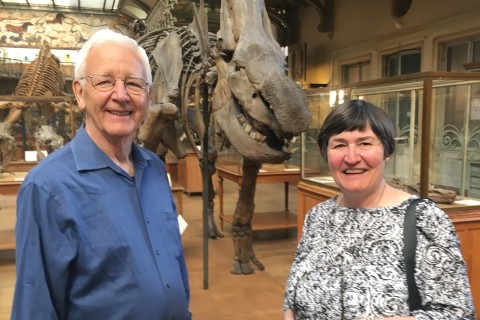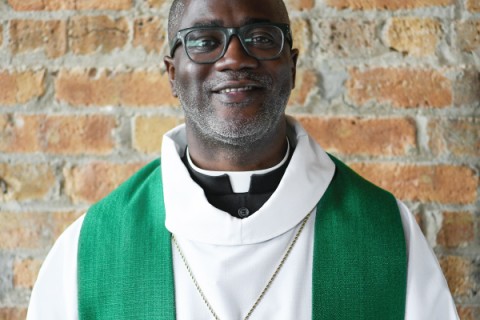A Whosoever Church, by Gary David Comstock
The title of Gary Comstock's book is based on John 3:16, one of the most frequently quoted New Testament passages: "For God so loved the world that he gave his only begotten son, that whosoever believeth in him should not perish but have everlasting life." Many Christians interpret this verse as establishing a creed of unconditional inclusivity.
Comstock's book presents a collection of interviews he conducted with various African-American clergy and scholars. Its subtitle is likely to catch the attention of a wide spectrum of the African-American community, whether religious or not. Why? Long before the Clinton's administration's "don't ask, don't tell" policy for gays and lesbians in the military, the African-American church had institutionalized the silencing of gay men and lesbians, while at the same time assigning them specific roles within the music ministry. This arrangement works well for churches if there is no public confession or acknowledgment of one's sexuality.
Comstock divides his interviews into four sections. The first, "Paving the Way," discusses the challenges of putting into practice theologies of inclusion. Typical of the responses in this section is the statement by Timothy McDonald, pastor of First Iconium Baptist Church in Atlanta, Georgia: "I do believe in sin, but how does one begin to move from condemning the sinner and throwing out the sinner with everything we perceive to be sinful?" Similarly, Larry C. Merryweather-Woods, senior pastor of Mount Moriah Missionary Baptist Church in Omaha, Nebraska, says, "I will not put one sin up against another. . . . When you use the text that homosexuality is an abomination before God, you should also look at what else is an abomination before God as well."
An intriguing political turn is supplied by Amos Brown, pastor of the historic Third Baptist Church of San Francisco: "White gays definitely promote their cause, and rightfully so, but when it comes to racial issues, they have exhibited some racial attitudes and bigotry." Brown alone among the interviewees refuses to participate in a dialogue on the supposed homophobia in African-American churches without giving equal attention to queer racism as well.
The first chapter concludes appropriately with an insightful testimony by Irene Monroe, a Ph.D. candidate in the Religion, Gender, and Culture Program at Harvard Divinity School. Speaking from her experience as an openly lesbian clergyperson of "bapticostal" roots, she expresses her disappointment in the ways in which African-Americans have selectively developed a "canon within a canon that gives us a sense of who we are (as African-American oppressed people), but we can't understand or do that when it comes to women, as well as when it comes to lesbian, gay, bisexual, and transgendered people." Such hermeneutical selectivity sets up what she calls hierarchies of oppression.
The second section, "Charting the Course," is intended to provide a glimpse of how African-American clergy design and implement strategies to make their congregations welcoming to gay men and lesbians. Unfortunately, none of the interviews in this chapter fulfills this intention. Chip Murray, pastor of the First AME Church in Los Angeles, points to church and society's perception of a heterosexual orientation as "normal" as a cause of homophobia. His critique is followed by an important explanation of black male masculinity, given by Raymond G. East, pastor of the Church of the Nativity of the Lord in Washington, D.C. East makes a rare but imperative connection between the role of black male masculinity and black male homosexuality.
"Making the Connections," the next part of the book, calls attention to urban churches in which gay people are integrated into church life . Edwin Sanders II, pastor of the Metropolitan Interdenominational Church in Nashville, Tennessee, bravely discusses the AIDS crisis within the context of the African-American church's stance on homosexuality. He specifically focuses on how this crisis pertains to church and gospel musicians. AIDS is a constant theme in the book, as most of those interviewed were forced to confront their homophobia only after many church members died of the disease. One wonders if these interviews would have the same accepting tone if there were no AIDS crisis.
The book concludes with "Reflection and Prophecy," presenting the statements of four academics and one church administrator. The voice of Emilie M. Townes stands out in this group. She rejects any narrow approach to these issues and instead presents a thought-provoking argument for the necessity in situating the conversation academically, denominationally and within the African-American community at large. Townes, an ordained American Baptist and professor of Christian ethics at Union Theological Seminary, was already engaged in scholarship concerning people of color and AIDS long before her favorite uncle died from AIDS complications. Her anger at the church's treatment of gay people deepened when her uncle emphatically stated that he did not want the pastor of her family's church to conduct his funeral. (Townes's uncle and family were founding members of his congregation.) "He didn't trust the pastor to put him away in a dignified way without judging him," Townes says.
Though Comstock's book is an important document, it falls short by not including the voices of African-American gay and lesbian church members. We need to hear the stories of those who actually suffer sexual oppression at the hands and mouths of those in the pulpit. By allowing the preachers to speak as the sole voice of the community, A Whosoever Church encourages a flawed part of the black church tradition.
The African-American church, locus of the civil rights movement, source and inspiration of African-American community and culture and birthplace of black liberation theology, has its own unique set of issues related to African-American gay men and lesbians. Comstock admits wondering whether he, as a white gay male, should be the person conducting these interviews.
Raising the question is certainly admirable and may initially arrest some criticisms, but one cannot help asking what it means that a white gay male is allowed access to a conversation that most African-American gay men and lesbians have not heard in their churches--at least not in any positive way. If they had the privilege of having such a discussion, there would probably be no need for this book. How different might these conversations have been--or could they have existed at all--were the interviewer an African-American gay man or lesbian?
A Whosoever Church may not be welcomed by African-American gay men and lesbians who feel theologically patronized by the "love the sinner, hate the sin" motif, a religious doctrine they know all too well. Oddly, despite the fact that most, if not all, of the pastors interviewed are seminary-trained, they deal very little with the question of biblical authority on the topic of sexuality. Not allowing for any questioning of the biblical text is yet another unfortunate trait of the African-American religious tradition. Indeed, it is often the most troubling trait for religious African-American lesbians and gay men, for how one learns to read and regard the Bible is a powerful tool for both oppression and liberation. Therefore, although Comstock's book is rich in testimony and attestation, its greatest failing is that the voices of oppressed African-American lesbians and gay men remain hidden behind the heroism of what could be labeled as the welcoming clergy. Though African-American churches may indeed welcome gay men and lesbians, they may not enjoy all the rights and privileges of other members.




